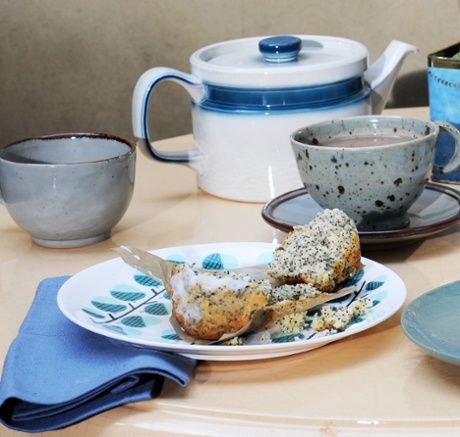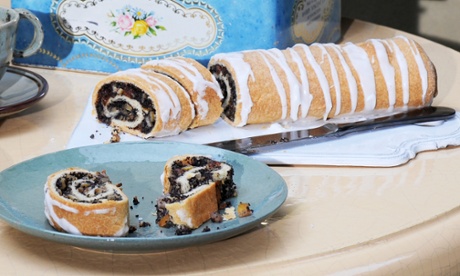Poppy seeds are a smash hit when combined with citrussynotes, such as in these lemon and basil muffins and this rolled Polish cake
Seeds often get pushed to the sidelines in baking, condemned to health foods and flapjacks, garnishes or wholesome loaves. It's a shame, because they're a fine alternative to nuts and grains. Poppy seeds in particular are a pleasure to cook with; their intense nutty, earthy flavour defies their minuscule size. They have a satisfying crunch - a speckling of crisp blue-black seeds in contrast with a mellow yellow crumb. Poppy seeds can be ground, too, into a fine meal that can be stirred into biscuits, marbled in cake batters or - as in the Polish poppy seed cake below - spiralled in soft bread dough.
Lemon, basil and poppyseed muffins
Achieving the same great heights and billowing volume as shop-bought muffins is pretty much impossible (unless you're happy to pack yours with additives), but a soft, airy texture isn't out of reach. The trick is a careful balancing act - a very stiff batter will give the characteristic domed top, but a dense, dry crumb; too much liquid and the cake will be light but flat-topped.

Makes 12-14
225g unsalted butter, softened
225g caster sugar
3 large eggs
2 tbsp milk
Zest of 3 lemons
275g plain flour
3 tsp baking powder
1/4 tsp salt
60g poppy seeds
2 small handfuls of basil leaves, finely chopped
125g icing sugar
30-40ml lemon juice
1 Preheat the oven to 180C/350F/gas mark 4 and line a 12-hole muffin tin with paper muffin cases.
2 Cream the butter with the sugar until smooth and light. This will take a few minutes by hand, but it's well worth it as the air incorporated now will yield lighter, fluffier muffins later. Stir in the eggs one at a time, followed by the milk and lemon zest. Don't panic if the mixture curdles a little: you can remedy this with the addition of just 1 tbsp or so of the flour.
3 In a separate bowl, stir together the flour, baking powder, salt, poppy seeds and basil, then add it to the wet mixture. Fold the ingredients together lightly, but thoroughly. Divide the batter between the muffin cases until each is roughly 3/4 full. If you under-fill the cases, the muffins will fall short of the brim; overfill and the muffin top will spill over - just work with whatever size paper cases you have, and make more or less muffins accordingly. You may have to bake in two batches.
4 Bake for around 20 minutes in the preheated oven, until the muffins are well-risen and golden brown. Leave to cool slightly. Whisk together the icing sugar with enough lemon juice to give a smooth icing then brush liberally over the top of each of the still-warm muffins. Let the muffins cool completely before serving.
Makowiec - Polish poppy seed cake
I'd never dare to call this an authentic makowiec recipe, but it's true to the original in spirit at least: soft, enriched dough swirled with a rich poppy seed filling.

Serves 6
125g plain flour
1 tsp instant dried yeast
1/4 tsp salt
1 large egg yolk
100ml milk
25g unsalted butter, softened
50g icing sugar
1-2 tsp orange juice
For the filling
75g poppy seeds
75ml milk
40g caster sugar
1 tbsp butter
1 tsp vanilla extract
Zest of 1 orange
40g raisins
25g mixed peel, finely chopped
25g walnuts
1 large egg white
1 First, make the filling. Blitz the poppy seeds in a coffee grinder or powerful food processor until coarsely ground. The seeds needn't be reduced to a powder, but they should be fractured and shattered, with few whole seeds left.
2 Combine the ground seeds with the milk, caster sugar and butter in a small pan and heat gently for a couple of minutes until it's hot and most of the milk has been absorbed. Take off the heat and stir in the vanilla extract, orange zest, raisins and peel. Grind the walnuts, then add these, too. In a separate bowl, whisk the egg white until foamy then fold into the poppy seed mix. Cool to room temperature.
3 Combine the flour, yeast and salt in a large bowl. Add the egg yolk, milk and butter and use your hands to bring the ingredients together into a dough. If the dough is very dry and there's excess flour left in the bowl, add a drop more milk. Knead on an unfloured work surface for 5-8 minutes, until very smooth, elastic and robust. Return the dough to its bowl to rest for 45 minutes. This resting period will give the yeast a chance to start working as well as letting the stretchy gluten relax, making the dough easier to roll out at the next stage.
4 Once the dough has rested and the filling mixture has cooled, roll the dough into a 20x30cm rectangle on a lightly floured surface. If the dough springs back as you roll it, just let it relax for a minute or two before carrying on. Spread the filling over the dough, leaving a border of about 2cm around the edges.
5 Gently roll up the dough rectangle from short edge to short edge. Tuck the edges in to prevent the filling seeping out during baking and transfer to a baking tray. Drape with clingfilm and leave to rise at room temperature for 60-90 minutes, or until the roll is puffy and spongy to the touch. Meanwhile, preheat the oven to 180C/350F/gas mark 4.
6 Once risen, bake the roll for 30-35 minutes. Leave to cool on a wire rack.
7 Stir the icing sugar together with just enough orange juice to give a smooth, but not runny, icing. Drizzle the icing over the cooled poppy seed roll.
‘Poppy seeds’ intense nutty, earthy flavour defies their minuscule size,’ says Ruby. Photograph: Jill Mead for the Guardian










